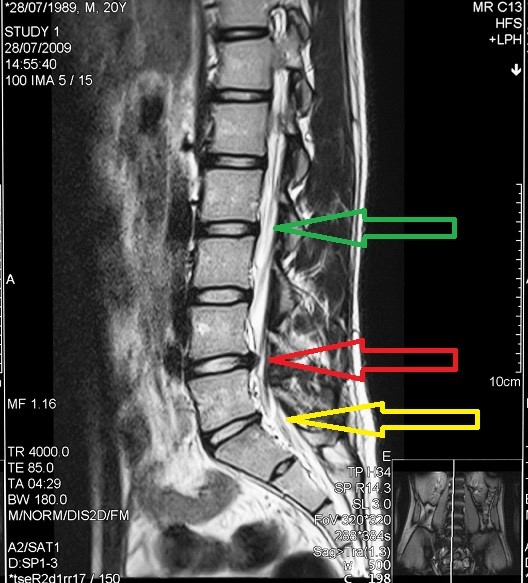
Most herniated disc injuries do not require surgery or invasive medical procedures. Chiropractors are often the preferred doctors for natural recovery of lower back pain caused by a herniated disc.
Green arrow: Normal disc
Red arrow: Herniated disc with significant spinal cord compression
Yellow arrow: Herniated disc with mild spinal cord compression
Non-Surgical Treatment For A Herniated Disc
First, your doctor will perform a thorough spine examination to determine the severity of your herniated disc injury and advise you of your treatment options. An X-ray or MRI test may be ordered to further evaluate the condition of the bones, joints and soft tissues. Fortunately, most disc injuries are not severe and can be diagnosed with a physical exam. The goal of disc herniation treatment is to relieve pressure on the injured disc and adjacent nerves to relieve pain and facilitate the healing. This can be accomplished without surgery through non surgical treatment. Here are treatment options for a herniated disc:
Spine Manipulation Therapy
Most back pains are physical and mechanical in nature. While medications are helpful for decreasing inflammation and relieving pain, a physical treatment approach will address the cause for the pain and prevent further injury. We use spine manipulation to treat the movement dysfunction causing pain in the disc , joints and muscles of the back. Spine manipulation is typically performed by the doctor's hands but special tools may also be used to to restore normal movement to the back, relieve pain, and facilitate the healing process. Movement is necessary for healing and quick recovery through natural joint lubrication and improved blood circulation to the surrounding muscle tissues. After mobility is restored, the spine can be strengthened trained through physical therapy exercises to prevent re-injury.
Spine Decompression and Traction
Spinal decompression therapy is a modern, non-surgical traction procedure that effectively treats herniated disc pain, leg pain and arm pain. This type of traction is very successful in relieving pain associated with disc herniation, degenerative disc disease, and foraminal stenosis syndromes. Spine decompression therapy relieve pressure on spinal discs and joints with traction and body positioning. By significantly reducing internal disc pressure, the herniated disc material is allowed to retract and relieve pressure on nerves causing back pain. It also promotes fluid intake, oxygen and other substances necessary for healing the disc and surrounding tissues.
Massage and Myofascial Release therapy
Physical Therapy Exercise
Fortunately, most people can get relief from a herniated disc without surgery or invasive procedures. Most cases of herniated discs will get better and heal with just ice and light exercise within 4-12 weeks. If the pain gets worse or doesn't get better with ice and exercise, chiropractic treatment is the recommended non-invasive treatment to accelerate recovery and prevent re-injury.
What Is A Herniated Disc?
A herniated disc is also known as a slipped disc. The discs are the rubber cushions that are found between the vertebrae. These discs are like jelly donuts in the sense that they have a soft center and a tough exterior wall. A herniated disc occurs when the soft jelly pushes out through a tear in the exterior wall. The herniated disc can put pressure on the nerves coming in and out of the spine causing pain, weakness and numbness into your arms or legs. In most cases, the pain, numbness and weakness will go away with time. However, if the symptoms do not improve within a few days, you should see your doctor for a spine examination.
What Causes A Herniated Disc?
The typical causes for a herniated disc are activities such as heavy lifting, strenuous exercise, athletic activities or trauma from falls or motor vehicle accidents. Many times the causes are less obvious and can be from bending down to tie your shoelaces, or turning to pick something up behind you.
As you age, the discs in your spine begin to lose some of their water content. This makes them less flexible and more prone to rupturing or tearing. Movements such as bending and twisting puts significant stress on the discs. Physical laborers and athletes are more susceptible to injuring their discs due to their repetitve bending and twisting movements. However, it is not uncommon for someone to herniate a disc just from sneezing.
Symptoms Of A Herniated Disc?
Common symptoms include:
- Neck Pain
- Back Pain
- Sharp, shooting pain into the arms or legs
- Numbness or Tingling into the arms or legs
- Muscle weakness of the arms or legs
- Abnormal muscle stiffness
- Pain with bending
- Pain with sitting
- Spine or pelvis is significantly shifted "out of alignment" or uneven
Symptoms may become worse with simple activities such as standing, sitting, walking, coughing, sneezing and laughing. Self diagnosing a herniated disc can sometimes be difficult because the level of pain does not always correlate with the severity of the disc herniation. Sometimes people may have an MRI showing a herniated disc but they do not have any symptoms. In contrast, others may have severe pain but the MRI doesn't show any disc abnormalities. If the symptoms do not improve on its own within a few days, it is best to visit a spine specialist for a full evaluation.
Each treatment session is 20-30 minutes and relief can be noticed in as little as 1 treatment.
Call us at (914) 421-1502 for more information about herniated disc pain treatment or to schedule an appointment.